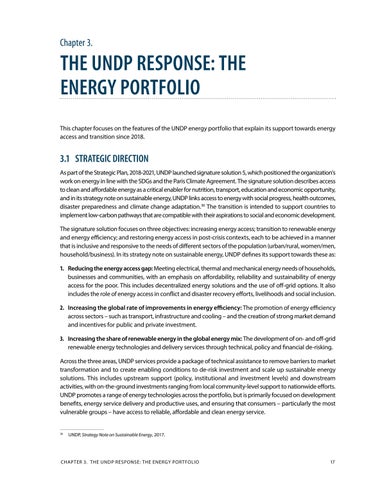Chapter 3.
THE UNDP RESPONSE: THE ENERGY PORTFOLIO This chapter focuses on the features of the UNDP energy portfolio that explain its support towards energy access and transition since 2018.
3.1 STRATEGIC DIRECTION As part of the Strategic Plan, 2018-2021, UNDP launched signature solution 5, which positioned the organization’s work on energy in line with the SDGs and the Paris Climate Agreement. The signature solution describes access to clean and affordable energy as a critical enabler for nutrition, transport, education and economic opportunity, and in its strategy note on sustainable energy, UNDP links access to energy with social progress, health outcomes, disaster preparedness and climate change adaptation.36 The transition is intended to support countries to implement low-carbon pathways that are compatible with their aspirations to social and economic development. The signature solution focuses on three objectives: increasing energy access; transition to renewable energy and energy efficiency; and restoring energy access in post-crisis contexts, each to be achieved in a manner that is inclusive and responsive to the needs of different sectors of the population (urban/rural, women/men, household/business). In its strategy note on sustainable energy, UNDP defines its support towards these as: 1. Reducing the energy access gap: Meeting electrical, thermal and mechanical energy needs of households, businesses and communities, with an emphasis on affordability, reliability and sustainability of energy access for the poor. This includes decentralized energy solutions and the use of off-grid options. It also includes the role of energy access in conflict and disaster recovery efforts, livelihoods and social inclusion. 2. Increasing the global rate of improvements in energy efficiency: The promotion of energy efficiency across sectors – such as transport, infrastructure and cooling – and the creation of strong market demand and incentives for public and private investment. 3. Increasing the share of renewable energy in the global energy mix: The development of on- and off-grid renewable energy technologies and delivery services through technical, policy and financial de-risking. Across the three areas, UNDP services provide a package of technical assistance to remove barriers to market transformation and to create enabling conditions to de-risk investment and scale up sustainable energy solutions. This includes upstream support (policy, institutional and investment levels) and downstream activities, with on-the-ground investments ranging from local community-level support to nationwide efforts. UNDP promotes a range of energy technologies across the portfolio, but is primarily focused on development benefits, energy service delivery and productive uses, and ensuring that consumers – particularly the most vulnerable groups – have access to reliable, affordable and clean energy service.
36
UNDP, Strategy Note on Sustainable Energy, 2017.
Chapter 3. THE UNDP RESPONSE: THE ENERGY PORTFOLIO
17


